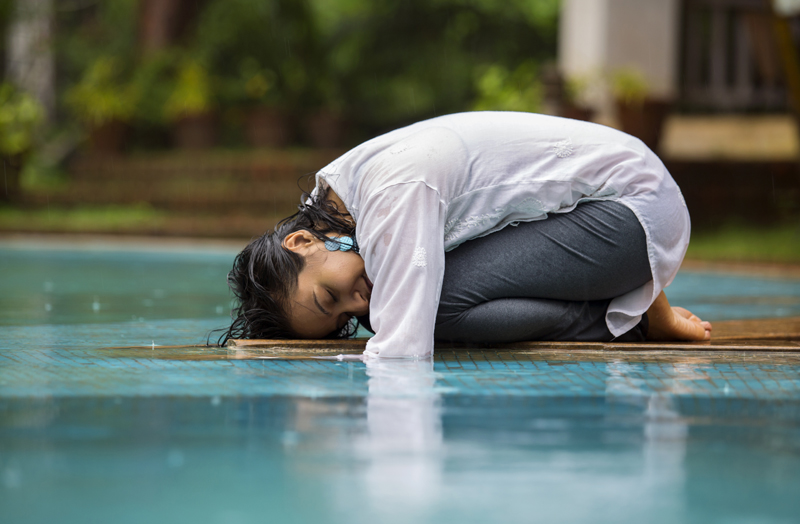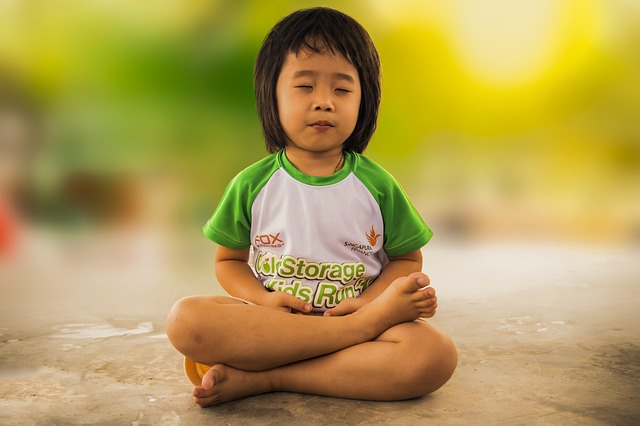The writer is a yoga and meditation expert and trains participants for various personality contests and conducts summer camps for kids and teens to help them have a healthy body and positive mind, the sessions are free for underprivileged children.
5 Ways to Teach Your Child to be Happy & Positive
Kerala is among the unhappiest demography in the country with depression sky rocketing. Women in Kerala are said to be even more stressed than their highly stressed counterpart in USA. Childrearing as a national average is skewed towards mothers, with fathers spending less than 15 minutes a day.
So how do we make our children happy despite the odds?
Exercise
 Global studies indicate that children who exercise are happier. 20-40 minutes of non competitive exercise is recommended where the objective is to ‘exercise’ and not to ‘ loose weight’ , ‘for performance’ etc. Children who practiced Vinyasa Yoga (moving with your breath), Tai Chi, Martial Arts, Dance, Trek, Swim for the joy of exercise were found to be better coordinated and happier. Such activities released a lot of dopamine and serotonin – happy hormones into their system. Children who did competitive sports were found to be more stressed, especially after the activity.
Global studies indicate that children who exercise are happier. 20-40 minutes of non competitive exercise is recommended where the objective is to ‘exercise’ and not to ‘ loose weight’ , ‘for performance’ etc. Children who practiced Vinyasa Yoga (moving with your breath), Tai Chi, Martial Arts, Dance, Trek, Swim for the joy of exercise were found to be better coordinated and happier. Such activities released a lot of dopamine and serotonin – happy hormones into their system. Children who did competitive sports were found to be more stressed, especially after the activity.
I would like to add the average health of children in Kerala is deplorable, be it about stamina, endurance, immunity and motor coordination even among ‘sports champs’ are far less compared to average children I have taught abroad. Children as young as 10 are unable to touch their toes , which has long term negative implications on their lower back. Most teens I meet, already have a slight hunch back.
Vinyasa yoga with its synchronous breathing and movements is a fabulous cardio, helps develop strength, flexibility, agility and focus. It is a fun, sweaty, full body workout that stretches and strengthens, builds physical immunity and mental resilience. Teach them a routine they can do, today and ensure they continue daily practice everyday.
Mindfulness Meditation
 Most children do not take to traditional meditation techniques, instead they are adept at mindfulness meditation. You only need to remind them to enjoy the moments, for instance if they have the habit of cycling or looking at the setting sun by the backwaters, teach them to be completely present and enjoy all the sensations – how the air feels, the colors they see, the scents, the sounds etc. 8 weeks of 15 minutes of mindfulness meditation daily will help them be more joyful, calm and creative and even create new neural pathways in the brain.
Most children do not take to traditional meditation techniques, instead they are adept at mindfulness meditation. You only need to remind them to enjoy the moments, for instance if they have the habit of cycling or looking at the setting sun by the backwaters, teach them to be completely present and enjoy all the sensations – how the air feels, the colors they see, the scents, the sounds etc. 8 weeks of 15 minutes of mindfulness meditation daily will help them be more joyful, calm and creative and even create new neural pathways in the brain.
Guided Visualization
Every happy child needs, happy memories – whether they are real or imagined. Create a 15 minute guided visualization routine where they are at their favourite spot in nature. With practice, visualization routines help shift brain waves from hyper beta to very soothing, healing alpha frequency.
Affirmations and Mirrors
Our thoughts and feelings have the energy to create our destiny. Teach your child from a very young age to repeatedly affirm a happy and positive day. ‘I am happy’, ‘ I am friendly’, ‘I am loved’, ‘ I am healthy’ , ‘ I am beautiful’ are affirmations that need to repeated as many times in a day as possible. The effects are better when done facing a mirror and said with a lot of energy and conviction.
Sharing and Gratitude
Those who share and are grateful for the small blessings are known to be happier – whether they are young or old. Sharing and attitude of gratitude helps release oxytocin, the morality drug that helps us bond, feel fulfilled and be joyful. Kids who share are less prone to be depressed and are more immune.
(As a parent, read up on child nutrition, unless the meals are balanced children tend to be restless, hyper or depressed and lethargic. Organizations like Unblind My Mind, clearly document relation of ‘ conditions like autism with diet. What you feed your child may be damaging them. Also ensure that they have unstructured play time of atleast an hour especially outdoors away from the screen.)
By Nuthan Manohar









































